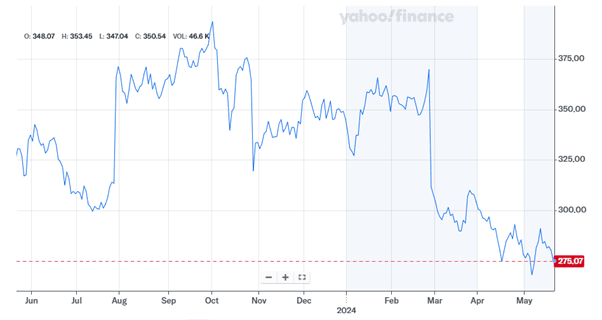Is Boston Beer the Next Big Buyout? Investors Buzz as Takeover Rumors Swirl!

In the world of craft beer, where bold flavors and innovative brewing dominate, Boston Beer Company (NYSE:SAM) has long stood out as a pioneer. However, recent developments have positioned this brewer as a tantalizing target for potential acquisition. Boston Beer's stock surged following a flurry of speculative buzz and an upgrade to 'Buy' at Jefferies, signalling increased investor interest. The origins of this surge? A report from Betaville, suggesting that giants like Heineken (OTCQX:HEINY) and Molson Coors (NYSE:TAP) could be eyeing Boston Beer for a takeover. Investors and industry watchers are now keenly observing Boston Beer, speculating on its future in an industry that thrives on both tradition and innovation. As takeover talks simmer, the key question remains: Why is Boston Beer such an attractive acquisition target and what are its biggest growth drivers?
The Boston Beer Company – Business Overview
The Boston Beer Company is a prominent player in the U.S. alcohol beverage industry, known primarily for its flagship Samuel Adams Boston Lager. The company produces a diverse range of alcoholic products, including beers, hard ciders, flavored malt beverages, and hard seltzers under various well-known brand names such as Twisted Tea, Truly Hard Seltzer, Angry Orchard, Dogfish Head, Angel City, Coney Island, and Havana Lager. Boston Beer sells its products through a network of about 400 wholesalers nationwide, who then distribute them to a variety of retail outlets, including grocery stores, club stores, convenience stores, liquor stores, bars, restaurants, stadiums, and other venues. Additionally, the company extends its market reach beyond the United States, exporting to Canada, Europe, Israel, Australia, New Zealand, the Caribbean, the Pacific Rim, Mexico, and Central and South America, making it a significant entity in both domestic and international markets.
Expanding Market Presence Through Strategic Brand Investments
The Boston Beer Company has been actively enhancing its brand portfolio and expanding its market presence, which are crucial elements driving its potential growth in the coming years. This strategy is evident in their substantial investments in marketing and promotional activities that are designed to increase brand awareness and customer engagement. The company's commitment to strengthening its core brands, such as Samuel Adams and Twisted Tea, is reflected in increased marketing expenditures aimed at both attracting new customers through media exposure and enhancing point-of-sale conversions. Moreover, Boston Beer's approach to maintaining robust relationships with distributors and retailers ensures enhanced market penetration and optimized shelf presence, which is vital for competitive advantage. The management's focused efforts on nurturing and expanding its core brand offerings while simultaneously pushing for innovation within the 'Beyond Beer' categories highlight a strategic push to not only solidify its standing in traditional markets but also to capture new growth avenues. This dual strategy of reinforcing core product lines while innovating in new categories is expected to underpin the company's growth trajectory by aligning with evolving consumer preferences and expanding into less saturated markets.
Leveraging Innovation and Product Diversification
Boston Beer's commitment to innovation and product diversification stands out as a significant growth driver. The company has shown a keen focus on developing new products that meet the changing tastes and preferences of consumers, which is crucial in the fast-evolving beverage industry. This is exemplified by their introduction of new products like Sun Cruiser, a vodka-based tea, and the expansion of the HARD MTN DEW line. By testing these innovations in smaller markets before rolling them out nationally, Boston Beer ensures that only the most promising products reach a wider audience, thereby optimizing resource allocation and potential returns on investment. The strategic emphasis on innovation not only helps retain consumer interest but also attracts new customers looking for unique beverage experiences. Furthermore, the company's ability to innovate within its existing brand frameworks, such as introducing new flavors or variants like Twisted Tea Light and higher-ABV options, supports its goals of market leadership and category dominance. As these innovations gain traction, they are expected to contribute significantly to volume growth and profitability, enhancing Boston Beer's market position and financial performance.
Enhancing Operational Efficiency and Margin Improvement
Enhancing operational efficiency and improving profit margins are central to Boston Beer's strategic objectives, as evidenced by its comprehensive margin enhancement initiatives and investments in technology. The introduction of a new automated customer ordering and inventory management system exemplifies the company's efforts to streamline operations and reduce waste, which is critical for improving bottom-line results. By optimizing their supply chain processes, Boston Beer aims to achieve quicker response times and better inventory management, resulting in less operational costs and enhanced service levels. Additionally, the focus on procurement savings and improved brewery performance indicates a strategic approach to cost management, which is increasingly important amid rising inflationary pressures. These efforts are complemented by a prudent pricing strategy that aims to offset cost increases while maintaining competitiveness in the market. Together, these operational improvements are designed to bolster the company's financial health by expanding gross margins and sustaining profitability, which are essential for long-term growth and investor confidence in a competitive industry landscape.
Final Thoughts

Source: Yahoo Finance
We can see how Boston Beer Company’s stock has lost value over the past year bringing it down to far reasonable valuations making the deal even more interesting for potential acquirers. Its EV/ Sales multiple which was as high as 2.22x last year is already down to 1.50x levels. It is important to highlight that the acquisition interest is not just about potential profits but more so, about the strategic alignments that could reshape the competitive landscape of the brewing industry. Analyst Kaumil Gajrawal of Jefferies recently highlighted that Boston Beer's Truly brand has stabilized after a volatile period, and its Twisted Tea brand continues to perform robustly. We believe that all these elements make Boston Beer an attractive proposition for larger companies looking to diversify their portfolios with established, profitable brands and that there is a very high likelihood of Boston Beer Company getting acquired in the near future.




